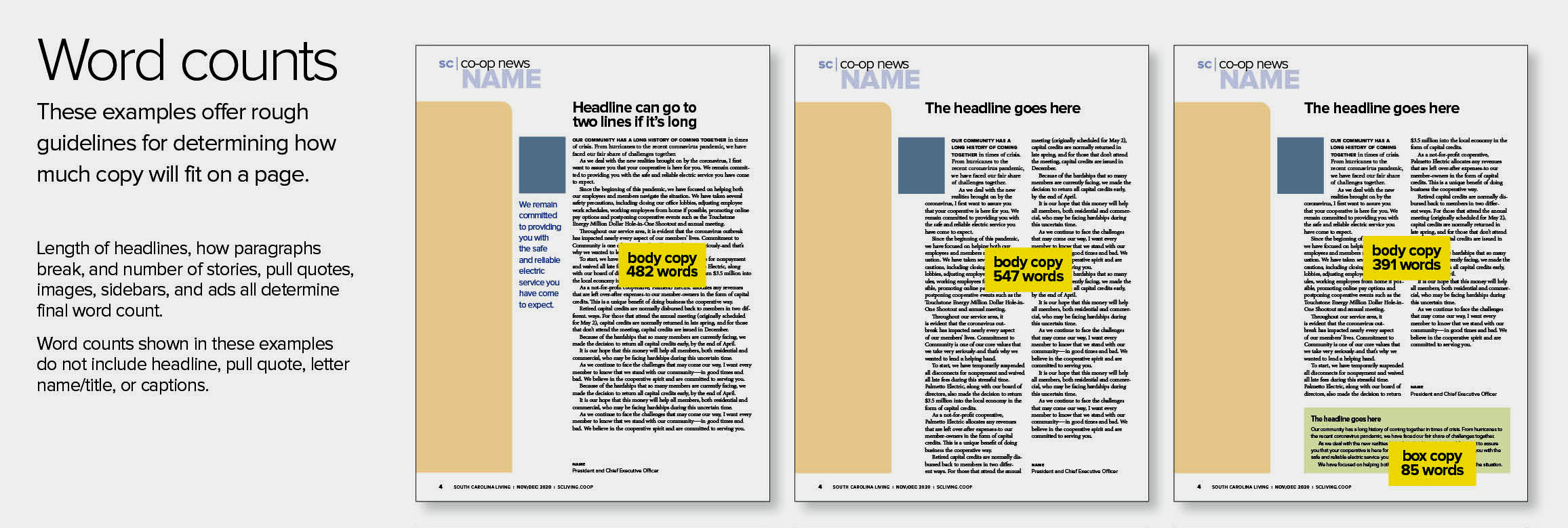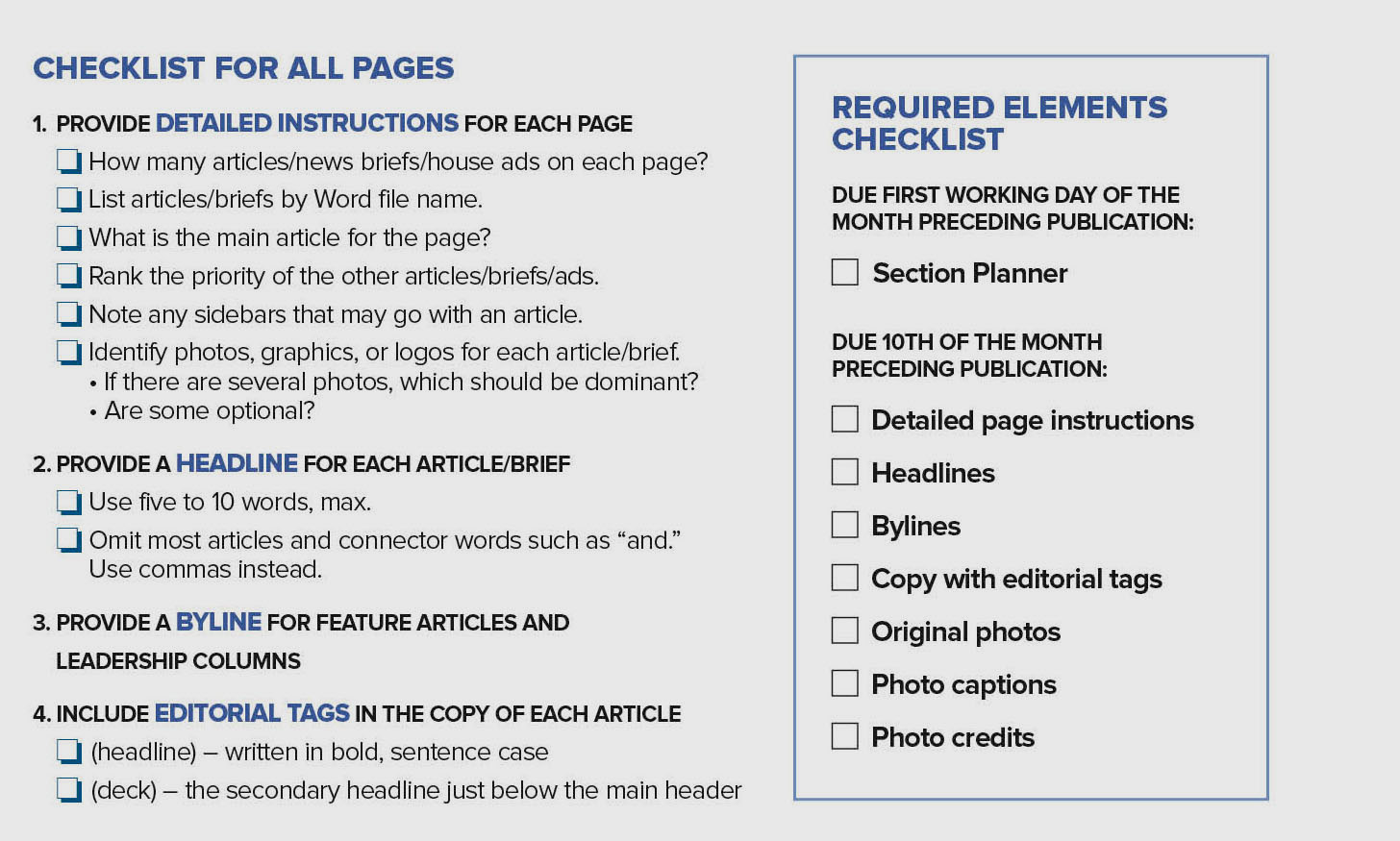Most associations and institutional communications rely on their members and officers for content. From CEO letters to web updates, the work of these contributors is indispensable to meet budgets and to gather news. But the struggle to collect content from these professionals—who have other duties and who are providing their work for free—can be like herding cats.
Even more challenging, many co-operative organizations must include “local” pages inserted into their statewide publications. Integrating the work of dozens of local affiliates to match the quality and style of the statewide pages every issue requires holding a lot of hands.
Editing is expected, but missed deadlines, off-topic content, writing too short or long, missing credits and captions, and grab-and-go images are problems that challenge the time and patience of communications staff everywhere.
The solution to getting the best out of your reluctant creatives is providing Standard Operating Procedure (SOP) Guidelines customized to encourage your participants to perform their tasks more readily. Even professional stringers benefit from clear instructions about content, style, and delivery.
.
Tell Them What You Want
Avoiding basic mistakes from the start can save a lot of time and effort. Clearly describing the rationale of their assignment is a great start.
The same sort of problems happens across many organizations that use outside contributors or solicit content from internal professionals whose job skills might not include journalism or photography. SOPs often include these suggestions.
An editorial “brief” should always accompany a story request. It should describe the scope of the piece and include a word count with a sample of the printed product as it will be used in the publication. Marrying the word count to a template demonstrates what keeping to the length looks like and encourages writers to write to space. This is better than simply saying, “one page of double-spaced text” or “write in an inverted pyramid and we’ll cut from the bottom.”

Ask contributors to preface their story with a short abstract. This can help editors understand the thrust of the piece so they can provide feedback for asking follow-up questions when polishing the initial draft. A good abstract can help writers focus and are even useful for TOC or web outtakes.
Provide a control checklist to avoid errors of omission. Processing the content submitted by members is much easier if a provided checklist of all the parts needed in the template is a required part of the submission package. A forgotten head, deck, subhead, byline, pull-quote, photo caption/credit, and bio—any standard element that is part of the editorial style—can be caught and included with the help of a handy list that can also demonstrate the proper editorial style.

No SOP is complete without a timeline (not a deadline.) Instead of demanding a deadline, emphasize the workflow and the place of the contributor in it. Then suggest several interim deadlines before the final for initial review, editing approval, and final go-ahead. Be sure to build in wiggle room at the end anyway, because, well, things happen. Distributing an official timeline makes all the contributors feel part of the team, showing when their content is integrated into the products helps build responsibility for the whole schedule.
.
Give Them Information They Need
Provide background instruction to help contributors deliver the best product by creating institutional, editorial, graphic, and workflow guidelines.
It’s a useful exercise to develop your unique “boilerplate” that can drill down to details that might seem condescending to professionals, but useful for other participants (frankly, many pros could benefit from this information too.)
Writing Guidelines. They can be as simple as “Avoid using the passive tense” to helpful suggestions for lede and closing graphs. In any event, avoid getting into the weeds with copy-editing preferences as they tend to bog down amateur writers’ free flow of thought.
Photography Guidelines. Contributors often are responsible for submitting images with their stories. Delivering images that are the proper resolution, data quality, and even composition is challenging for many people, so a sheet on the proper way to shoot, save and submit images saves a lot of back-and-forths. For example, images should be saved and sent without manipulation despite the urge to use in-camera tools. An image sent from a smartphone can unknowingly be resized smaller on the fly — make sure the original data is sent.
Photoshoot Tips. Even inexpensive cameras are great for taking pictures and newer smartphones have excellent cameras. A few simple rules to help improve taking pictures is more critical. The rules are pretty simple too—get close to the subject, take lots of pictures, shoot multiple images of the same thing, shoot vertically and horizontally, and only use the flash if nothing else works. Encourage sending more than one possibility if there is enough coverage.
Beyond the basics, a thorough guide on the types of images, the number used in stories, and suggestions for compositions that can help designers with creative layout. American Style was a magazine about fine crafts and the people who collected them. It featured stories about how crafts were displayed as part of the interior design of collector’s homes. To ensure that the photoshoots from many different photographers met the needs of the magazine’s mission and the design requirements of the image-heavy layouts, we created these Photoshoot Guidelines with detailed specifications for the types of compositions and subject matter.
.
Help Them Help You
Providing information is one thing; getting compliance is harder. But there are ways to get even the most reticent contributors on-board.
Provide helpful support. A single contact who works with contributors builds camaraderie and trust and improves response. Editors who spend extra time with contributors developing column topics and possible story directions both increases engagement and commitment.
Clearly define scope. If you want a regular columnist or feature contributor, it helps to define the scope of the content and the amount of work required. Enthusiastic participation comes from people who understand what they are supposed to deliver and when. That is why writing a creative brief for all submissions is a valuable exercise in limiting the scope of what is requested and what kind of content is needed—both are critical factors in getting what is needed with maximum efficiency.
Value expertise. Find contributors who have recognized expertise about the content you want. Value expertise over writing skill and previous experience providing content. Ask involved people who they recommend with knowledge on a specific topic within your membership or organization. The credibility of your published content providers is an asset that encourages others to participate.
Encourage contributors. It’s hard to remember that most contributors are not only doing something that is “not my job” but they are doing it in addition to their official duties. It is amazing what positive feedback and continuous gratitude will to for the quality and punctuality of submissions. There are many reasons that coworkers or members like to contribute. One thing that unites them is that they like being part of a team. Reminding everyone of the valuable part they play works wonders.